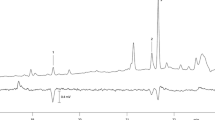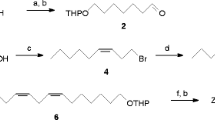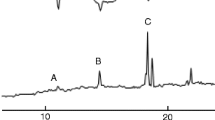Abstract
A sex pheromone of the sweetpotato weevil,Cylas formicarius elegantulus (Summers), was obtained from collections of volatiles from virgin females, and pheromone was isolated by means of liquid and gas chromatography. The purification procedure was monitored by quantitative laboratory and field bioassays and the compound was identified as (Z)-3-dodecen-1-ol (E)-2-butenoate by means of spectroscopic and microchemical methods. Synthesis, followed by laboratory and field bioassays, showed that the biological activity of the synthetic material was qualitatively and quantitatively indistinguishable from that of the purified natural product.
Similar content being viewed by others
References
Akazawa, T., Uritani, I., andKubota, H. 1960. Isolation of ipomoeamarone and two coumarin derivatives from sweet potato roots injured by the weevil,Cylas formicarius elegantulus.Arch. Biochm. Biophys. 88:150–156.
Anonymous. 1978. Postharvest Food Losses in Developing Countries. FAO. 206 pp.
Anonymous. 1981. FAO Production Yearbook 1980. Statistics Series. Vol. 34, 296 pp.
Brownlee, R.G., andSilverstein, R.M. 1968. A micro-preparative gas chromatograph and a modified carbon skeleton determinator.Anal. Chem. 40:2077–2079.
Beroza, M., andBierl, B.A. 1967. Rapid determination of the olefin position on organic compounds in microgram range by ozonolysis and gas chromatography.Anal. Chem. 38:1131–1135.
Coffelt, J.A., Vick, K.W., Sower, L.L., andMcClellan, W.T. 1978. Sex pheromone of the sweetpotato weevil,Cylas formicarius elegantulus: Laboratory bioassay and evidence for a multiple component system.Environ. Entomol. 7:756–758.
Heath, R.R., andDoolittle, R.E. 1983. Derivatives of cholesterol cinnamate: A comparison of the separations of geometrical isomers when used as gas chromatographic stationary phases.J. High Resol. Chromatogr. 6:16–19.
Klassen, W., Ridgway, R.L., andInscoe, M. 1982. Chemical attractants in integrated pest management programs, pp. 13–130,in A.F. Kydonieus and M. Beroza (eds.). Insect Suppression with Controlled Release Pheromone Systems. CRC Press, Boca Raton, Florida.
Kovats, E. 1965. Retention index system.Adv. Chromatogr. 1:229–234.
Martin, F.W. 1983. Goals in breeding the sweet potato for the Caribbean and Latin America.Proc. Am. Soc. Hortic. Sci. Trop. Sect. 27(B):61–70.
Mozingo, R. 1955. Palladium catalysts.Org. Synth. 3:685–690.
Proshold, F.I. 1983. Mating activity and movement ofCylas formicarius elegantalus (Coleoptera: Curculionidae) on sweet potato.Proc. Am. Soc. Hortic. Sci., Trop. Sect. 27(B):81–92.
Uritani, I., Saito, H., Honda, H., andKim, W.K. 1975. Induction of furanoterpenoids in sweet potato roots by the larval components of the sweet potato weevils.Agric. Biol. Chem. 39:1857–1862.
Author information
Authors and Affiliations
Additional information
Mention of a commercial or proprietary product does not constitute an endorsement by the USDA.
Rights and permissions
About this article
Cite this article
Heath, R.R., Coffelt, J.A., Sonnet, P.E. et al. Identification of sex pheromone produced by female sweetpotato weevil,Cylas formicarius elegantulus (Summers). J Chem Ecol 12, 1489–1503 (1986). https://doi.org/10.1007/BF01012367
Received:
Accepted:
Issue Date:
DOI: https://doi.org/10.1007/BF01012367




